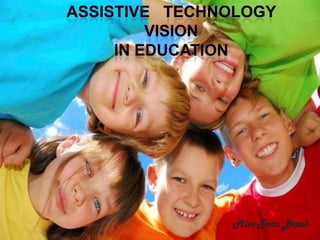Assistive technology
- 2. ~Menu~ Assistive Technology for Vision Indiana School Microsoft Photosensitive for the Blind Products Epilepsy
- 3. Indiana School for the Blind and Visually Impaired The Indiana School for the Blind and Visually Impaired educates on-site approximately 175 students in grades preschool through high school with students ranging from 3 to 22 years of age. The School's focus as an educational institution to this unique population is two fold: first to teach students or who have low vision how to master the Indiana core curriculum at the level identified on each student's Individual Education Plan and also to work with each student through an expanded core curriculum, one that teaches students how to navigate their http://www.isbvik12.org/ physical, social and personal world.
- 4. Reflection Every day I drive past the sign that says, âIndiana School of Blindâ this way, and I always wonder how the school helps children with visual impairments and blindness. As I researched over the site I was surprised the most by the courses offered at the school. They even have short courses where the student can stay at his/her local school, but take a class in * Braille * Orientation & Mobility * Computer & assistive technology * Visual efficiency * Study skills * Independent living * Career education * Interpersonal skills * Physical education Treat children as though they are already the people they are capable of becoming. âHaim Ginott
- 5. ~Ah Ha Moment~ The Indiana School for the Blind and Visually Impaired was established in 1847. The School has grown into an institution that provides educational resources that include both a residential program and a day school, outreach services, and consultative services to those in local agencies.
- 6. Microsoft Products Guide for Individuals with Vision Impairments - Vision difficulties and impairments include low vision, color blindness, and blindness. Among adult computer users in the United States, 1 in 4 (27%) have a vision difficulty. There are many options for individuals with vision difficulties to modify their computer displays and appearance to make them easier to see, or, alternatively, to receive information through sound or touch. Below are a list of assistive technology programs people with visual impairments can use. ïķ Screen magnifiers ïķ Screen readers ïķ Speech recognition ïķ Speech synthesizers ïķ Braille embossers ïķ Talking word processors http://www.microsoft.com/e nable/at/
- 7. Microsoft has come out with different products to help users with all different types of impairments. For example Microsoft has made a key board specially made for the visually impaired. As technology becomes more diverse it is helpful for these students so they can learn and still complete their education. As a future teacher it is important that all of my students have the tools accessible to them so they have an equal opportunity of learning and completing their school work.
- 8. The National Health Interview Survey (NHIS) Provisional Report established that an estimated 25.2 million adult Americans reported they either "have trouble" seeing, even when wearing glasses or contact lenses, or that they are blind or unable to see at all.
- 9. Photosensitive Epilepsy âĒ Epilepsy affects more than three million Americans. For about 3 percent of them, exposure to flashing lights at certain intensities or to certain visual patterns can trigger seizures. This condition is know Photosensitive epilepsy. It is more common in children and adolescents. âĒ To help control the seizures use: -Computer Monitors - A flicker-free monitor (LCD display or flat screen). - A monitor glare guard. -Wear non-glare glasses to reduce glare from the screen. -Take frequent breaks from tasks involving the computer. http://www.epilepsyfoundation.org/abo ut/photosensitivity/
- 10. More and More Reflection children are needing glasses, contacts at an early age. As a future teacher we need to be aware of students and watch for signs that they may need corrective eye wear. Also in schools we need to be fully equipped with the tools to help reduce students with photosensitive Epilepsy.
- 11. A h h a M o m e n t Seizures in photosensitive people may be triggered by exposure to television screens due to the flicker or rolling images, to computer monitors, to certain video games or TV broadcasts containing rapid flashes or alternating patterns of different colors, and to intense strobe lights like visual fire alarms.
- 12. Resources ï§ Hargis, E.R. (1996). Epilepsy foundation. Retrieved from http://www.epilepsyfoundation.org/ ï§ Indiana school for the blind and visually impaired. Retrieved from http://www.isbvik12.org/ ï§ Microsoft Corporation. (2009, December fourth). Assistive technology products. Retrieved from http://www.microsoft.com/enable/at/











